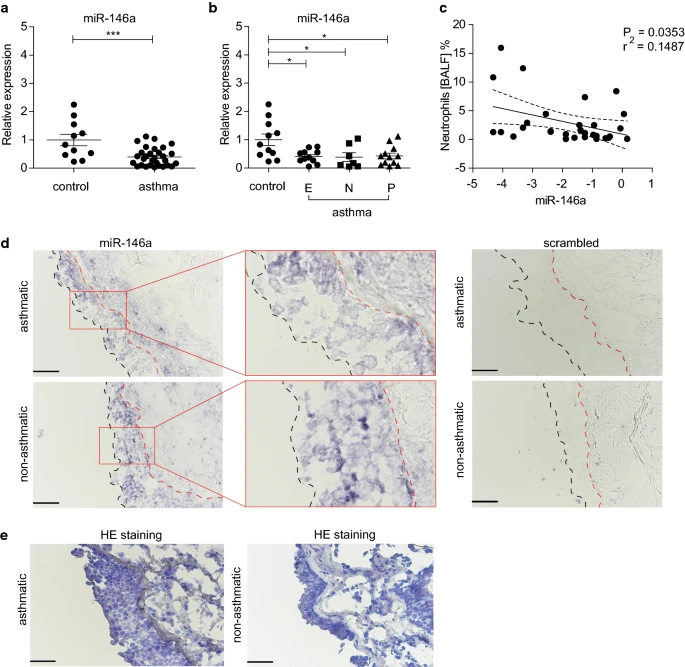Research – Open Access
Anet Kivihall, Alar Aab, Jerzy Soja, Krzysztof Sładek, Marek Sanak, Alan Altraja, Bogdan Jakiela, Grazyna Bochenek & Ana Rebane
Clinical and Translational Allergy volume 9, Article number: 62 (2019)

Abstract
Background
The role of miRNAs in the pathogenesis and determining the phenotypes of asthma is not fully elucidated. miR-146a has been previously shown to suppress inflammatory responses in different cells. In this study, we investigated the functions of miR-146a in human bronchial epithelial cells (HBECs) in association with neutrophilic, eosinophilic, and paucigranulocytic phenotypes of asthma.
Methods
Bronchial brushing specimens and brochial mucosal biopsy samples were collected from adult patients with asthma and from age- and gender-matched non-asthmatic individuals. The expression of miR-146a in bronchial brushing specimens, bronchial biopsy tissue sections or cultured primary bronchial epithelial cells was analyzed by RT-qPCR or by in situ hybridization. The expression of direct and indirect miR-146a target genes was determined by RT-qPCR or ELISA. The migration of neutrophils was studied by neutrophil chemotaxis assay and flow cytometry. For statistical analysis, unpaired two-way Student’s t test, one-way ANOVA or linear regression analysis were used.
Results
Reduced expression of miR-146a was found in bronchial brushing specimens from asthma patients as compared to non-asthmatics and irrespective of the phenotype of asthma. In the same samples, the neutrophil attracting chemokines IL-8 and CXCL1 showed increased expression in patients with neutrophilic asthma and increased IL-33 expression was found in patients with eosinophilic asthma. Linear regression analysis revealed a significant negative association between the expression of miR-146a in bronchial brushings and neutrophil cell counts in bronchoalveolar lavage fluid of patients with asthma. In bronchial biopsy specimens, the level of miR-146a was highest in the epithelium as determined with in situ hybridization. In primary conventional HBEC culture, the expression of miR-146a was induced in response to the stimulation with IL-17A, TNF-α, and IL-4. The mRNA expression and secretion of IL-8 and CXCL1 was inhibited in both stimulated and unstimulated HBECs transfected with miR-146a mimics. Supernatants from HBECs transfected with miR-146a had reduced capability of supporting neutrophil migration in neutrophil chemotaxis assay.
Conclusion
Our results suggest that decreased level of miR-146a in HBECs from patients with asthma may contribute to the development of neutrophilic phenotype of asthma.
